AUDI S3 SEDAN 2015 Owners Manual
Manufacturer: AUDI, Model Year: 2015, Model line: S3 SEDAN, Model: AUDI S3 SEDAN 2015Pages: 282, PDF Size: 71.14 MB
Page 251 of 282
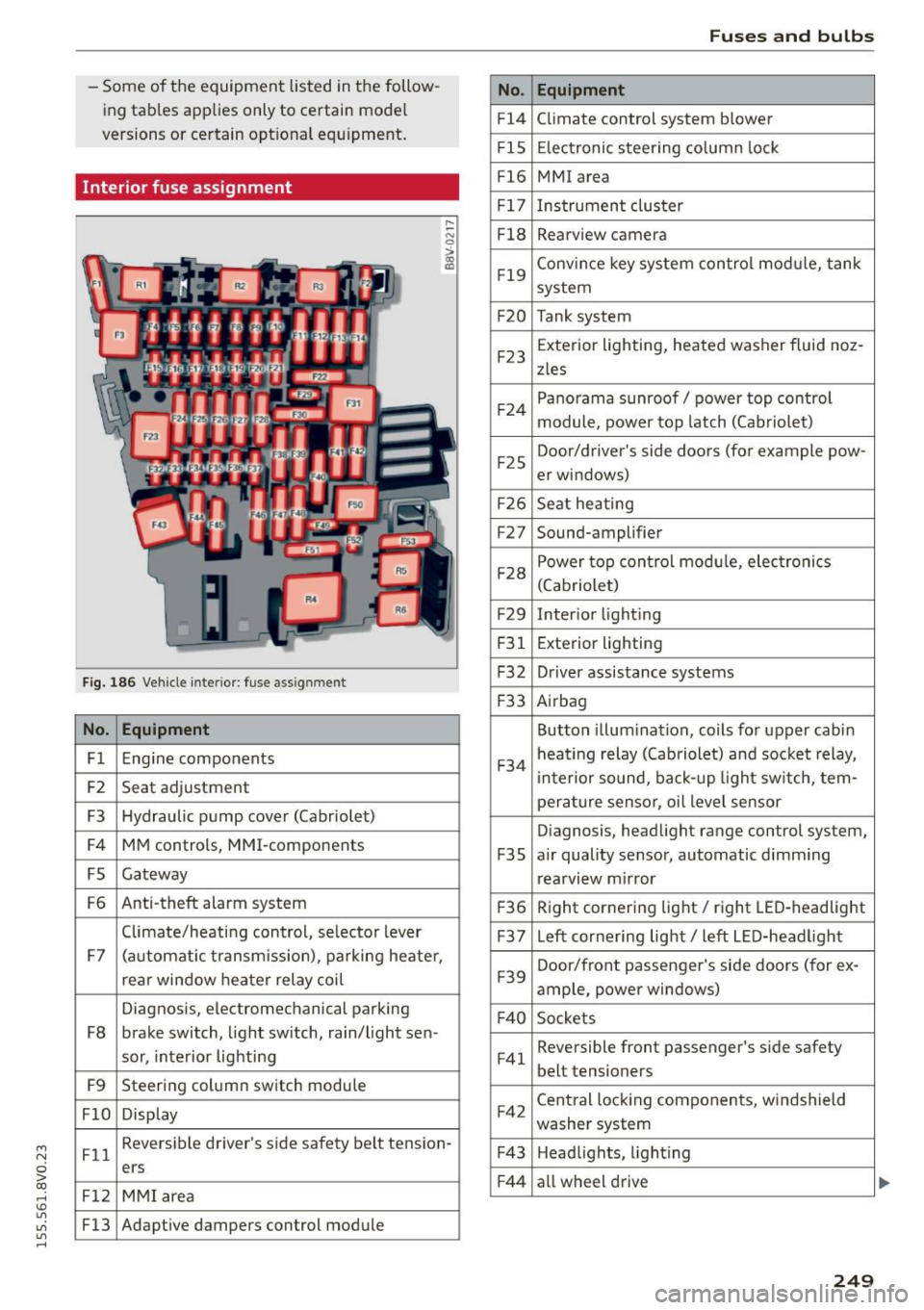
....,
N
0 > co
rl I.O
"'
"'
"'
rl
-Some of the equipment listed in the follow
ing tables applies only to certain model
versions or certain opt ional equ ipment.
Interior fuse ass ignment
F ig. 186 Vehicle interior: fuse assignment
No. Equipment
Fl Engine components
F2 Seat
adjustment
F3 Hydraulic pump cover (Cabriolet)
F4 MM
controls, MMI-components
FS Gateway
F6 Anti-theft
alarm system
Climate/heati ng control, selector lever
F7 (automat ic transm ission), parking heater,
rear window heater relay coil
Diagnosis, electromechanical parking
F8 brake switch, light switch, rain/light sen-
sor, interior lighting
F9 Steering column switch module
FlO Display
.... ~ N
0
>
"' (0
Fll Reversible
driver's side safety belt tension-
ers
F12 MMI area
F13 Adapt ive dampers control module
No.
Fl4
FlS
Fl6
F 1 7
F18
F19
F20
F23
F 24
F 25
F 26
F27
F28
F29
F 31
F32
F 33
F34
F3S
F 36
F37
F 39
F 40
F 41
F42
F43
F 44
Fu ses a nd bulb s
Equipment
Climate control system blower
Electronic steering co lumn lock
MMI area
Instrument cluster
Rearview camera
Conv ince key system control mod ule, tank
system
Tank system
Exterior lighting, heated washer fluid noz-
zles
Panorama sunroof/ power top control
module, power top latch (Cabriolet)
Door/driver 's side doors (for example pow-
er windows)
Se at heating
Sound-amplifier
Power top control modu le, electronics
(Cab riolet)
Inter ior light ing
E xterior lighting
Driver assistance systems
Airbag
Button illumination, coils for upper cabin
heating relay (Cab riolet) and socket relay,
i nte rior sound, back- up light sw itch, tern-
perature sensor, oi l level sensor
Diagnosis, headlight range control system,
a ir quality sensor, automatic d imming
rearview m irror
Right cornering light/ right LED-headlight
Left cornering light/ left LED-headlight
Door/front passenger's side doors (for ex-
ample, power windows)
Sockets Reversible front passenger's side safety
belt tensioners
Central locking components, windshield
washer system
Head lights, l ight ing
a ll wheel drive
249
Page 252 of 282
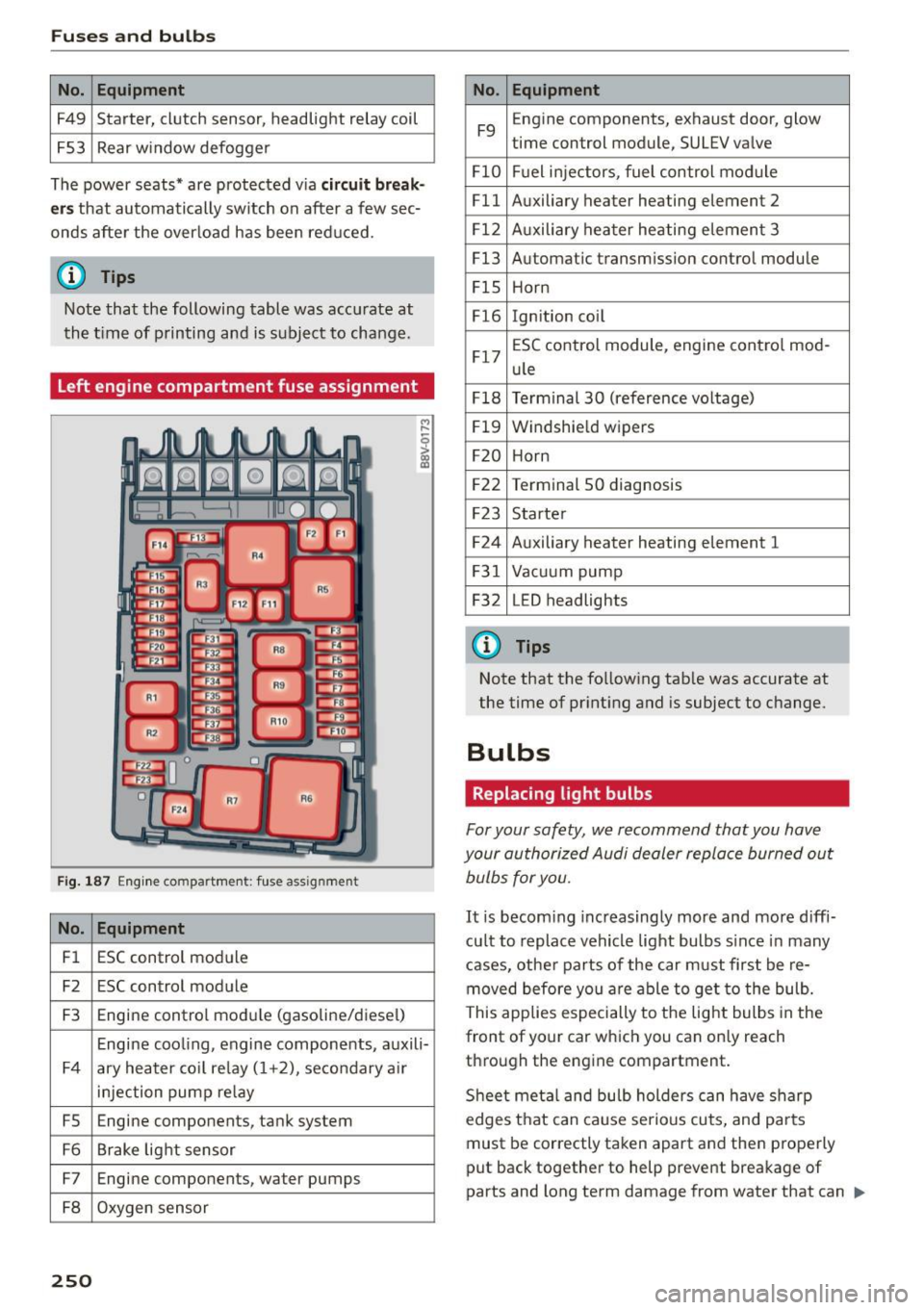
Fuses and bulbs
No. Equipment
F49 Starter, clutch sensor,
headlight relay coil
F53 Rear window defogger
The power seats* are protected via
circuit break
ers
that automatically switch on after a few sec
onds after the overload has been reduced.
(0 Tips
Note that the following table was accurate at
the time of printing and is subject to change.
Left engine compartment fuse assignment
Fig. 187 Engine compartmen t: fuse assig nme nt
No. Equipment
Fl ESC control module
F2 ESC control module
F3 Engine control module (gasoline/diesel)
Engine cooling, engine components, auxili-
F4 ary heater coil relay (1+2), secondary a ir
injection pump relay
FS Engine components, tank system
F6 Brake light sensor
F7 Engine components, water pumps
F8 Oxygen sensor
250
No. Equipment
F9 E
ngine components, exhaust door, glow
time control module, SULEV valve
Fl0 Fuel injectors, fuel control module
Fll Auxiliary heater heating element 2
F12 Auxiliary heater heating element 3
F13 Automatic transmission control module
FlS Horn
F16 Ign ition coil
F17 ESC
control module, engine contro l mod-
ule
F18 Terminal 30 (reference voltage)
F19 Windshie
ld wipers
F20 Horn
F22 Terminal 50 diagnosis
F23 Starter
F24 Auxiliary heater heating element 1
F31 Vacuum pump
F32 L
ED headlights
(!') Tips
Note that the following tab le was accurate at
the time of printing and is subject to change.
Bulbs
Replacing light bulbs
For your safety , we recommend that you have
your authorized Audi dealer replace burned out
bulbs for you.
It i s becoming increasingly more and more diffi
cu lt to replace vehicle light bulbs s ince in many
cases, other parts of the car must first be re
moved before you are able to get to the bulb.
This applies especially to the light bulbs in the
front of your car which you can only reach
through the engine compartment.
Sheet meta l and bulb holders can have sharp
edges that can cause serious cuts, and pa rts
must be correctly taken apart and then properly
put back together to help prevent breakage of
parts and long term damage from water that can .,,_
Page 253 of 282

M N
0 > co ,...., \!) ..,.,
..,.,
..,., ,....,
enter housings that have not been properly re
sealed .
F or your safety, we recommend that you have
your author ized Audi dealer replace any bulbs for
you, since your dealer has the proper tools, the
correct bulbs and the expertise .
Gas disc har ge la mps (X enon li g ht s):
Due to the high electrical voltage, have the bulbs
replaced by a qualif ied techn ician . H eadlights
with Xenon light can be identified by the high
voltage sticke r.
L ED headlights* requ ire no ma intenance . Please
contact your authorized Audi dealer if a bulb needs to be replaced .
_& WARNING
Contact with high-voltage components of the
electrical system and improper replacement
o f gas discharge (Xenon) headlight bu lbs can
cause serious personal injury and death.
- Xenon bulbs are pressurized and can ex -
plode when being changed.
- C hang ing Xenon lamps requires the spe cial
training, instructions and equipment .
- Only an authorized Aud i dea ler or othe r
qualified workshop shou ld change the bulbs
in gas discharge lamps.
_& WARNING
There are parts with sharp edges on the open ings and on the b ulb holders that can cause
ser ious c uts.
- If you are uncertain about what to do, have
the work performed by an author ized Audi
dealer or other qualif ied workshop. Ser ious
persona l injury may result from improperly
performed work .
- If you still pre fer to replace the light bulbs
yourself, be aware that the engine compart
ment is a hazardous area to work in
i:> page l 98 i:> .&
-It is best to ask your authorized A udi dealer
whenever you need to change a bulb.
Fu ses a nd bulb s
251
Page 254 of 282
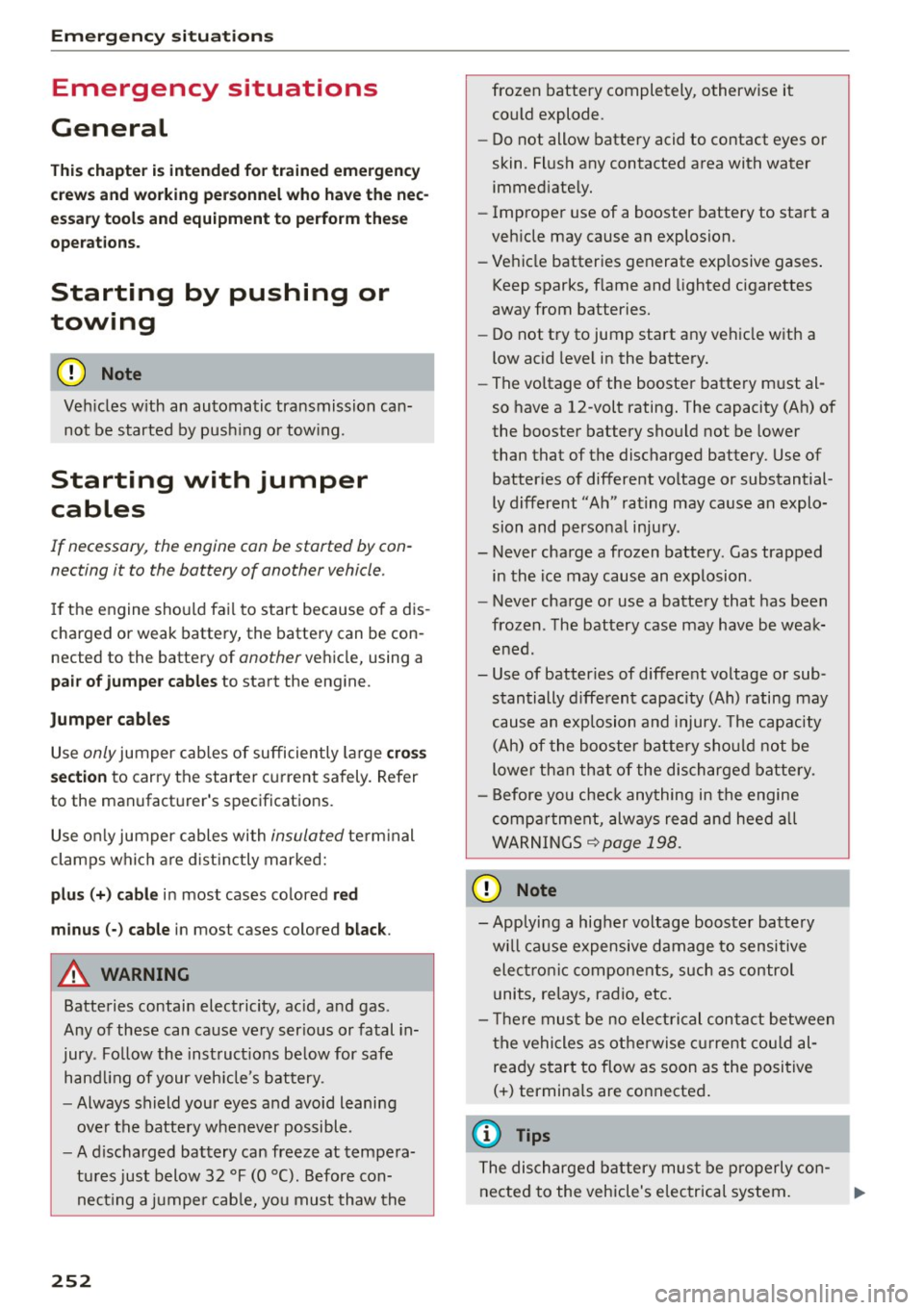
Emerg enc y s it uat ion s
Emergency situations
General
T his c hapt er is inte nded fo r tra ined e merg ency
c rews a nd worki ng p ers onn el w ho h ave the nec
e ssa ry tool s and equipm ent t o perf orm the se
op era tion s.
Starting by pushing or
towing
CD Note
Veh icles w ith an automatic transmission can
not be started by push ing or tow ing.
Starting with jumper
cables
If necessary, the engine con be started by con
necting it to the battery of another vehicle .
If the engine should fail to start because of a d is
charged or weak battery, the battery can be con
nected to the battery of
another vehicle, using a
p air o f jump er ca bles to start the engine.
Jump er c able s
Use only jumper cables of sufficiently large cr oss
se ction
to carry the starter current safely. Refer
to the manufacturer's specifications.
Use on ly jumper cables with
insulated term inal
clamps which are d istinctly mar ked:
pl us( +) cabl e in most cases co lored re d
minu s(-) cable
in most cases colored black .
A WARNING
Batteries contain electricity, ac id, and gas.
Any of these can cause very ser ious or fatal in
jury . Follow the inst ruct ions be low for safe
hand ling of your veh icle's battery.
- Always shield your eyes and avoid leaning
over the battery w henever possible.
- A discharged battery can freeze at tempera
tures just below 32
°F (0 °C). Before con
nect ing a jumper cab le, you must thaw the
25 2
frozen battery completely, otherwise it
could explode.
- Do not allow battery acid to contact eyes or
skin. Flush any contacted area with water immediately.
- Improper use of a booster battery to start a
veh icle may cause an explosion.
- Vehicle batteries generate explosive gases .
Keep sparks, flame and lighted cigarettes
away from batteries.
- Do not try to jump start any vehicle with a
low acid level in the battery.
- The voltage of the booster battery must al
so have a 12-volt rating. The capacity (Ah) of
the booster battery should not be lower
than that of the discharged battery. Use of
batter ies of different voltage or substantial
ly different "Ah" rating may cause an explo
sion and personal injury.
- Never charge a frozen battery. Gas trapped in the ice may cause an explosion .
- Never charge or use a battery that has been
frozen. The battery case may have be weak
ened .
- Use of batter ies of different voltage or sub
stantially d ifferent capacity (Ah) rating may
cause an explosion and injury. The capacity
(Ah) of the booster battery should not be
lowe r than that of the discharged battery.
- Before you check anything in the engine
compartment, always read and heed a ll
WARNINGS
qpoge 198.
CD Note
-App lying a higher voltage booster battery
wi ll cause expensive damage to sensitive
elec tronic components, such as control
units, re lays, radio, etc.
- T here must be no electrical contact between
the vehicles as otherwise cu rrent cou ld al
ready start to flow as soon as the positive
(+) termina ls are connected.
@ Tips
The discharged battery must be properly con-
nected to the vehicle's electrical system. .,.
Page 255 of 282
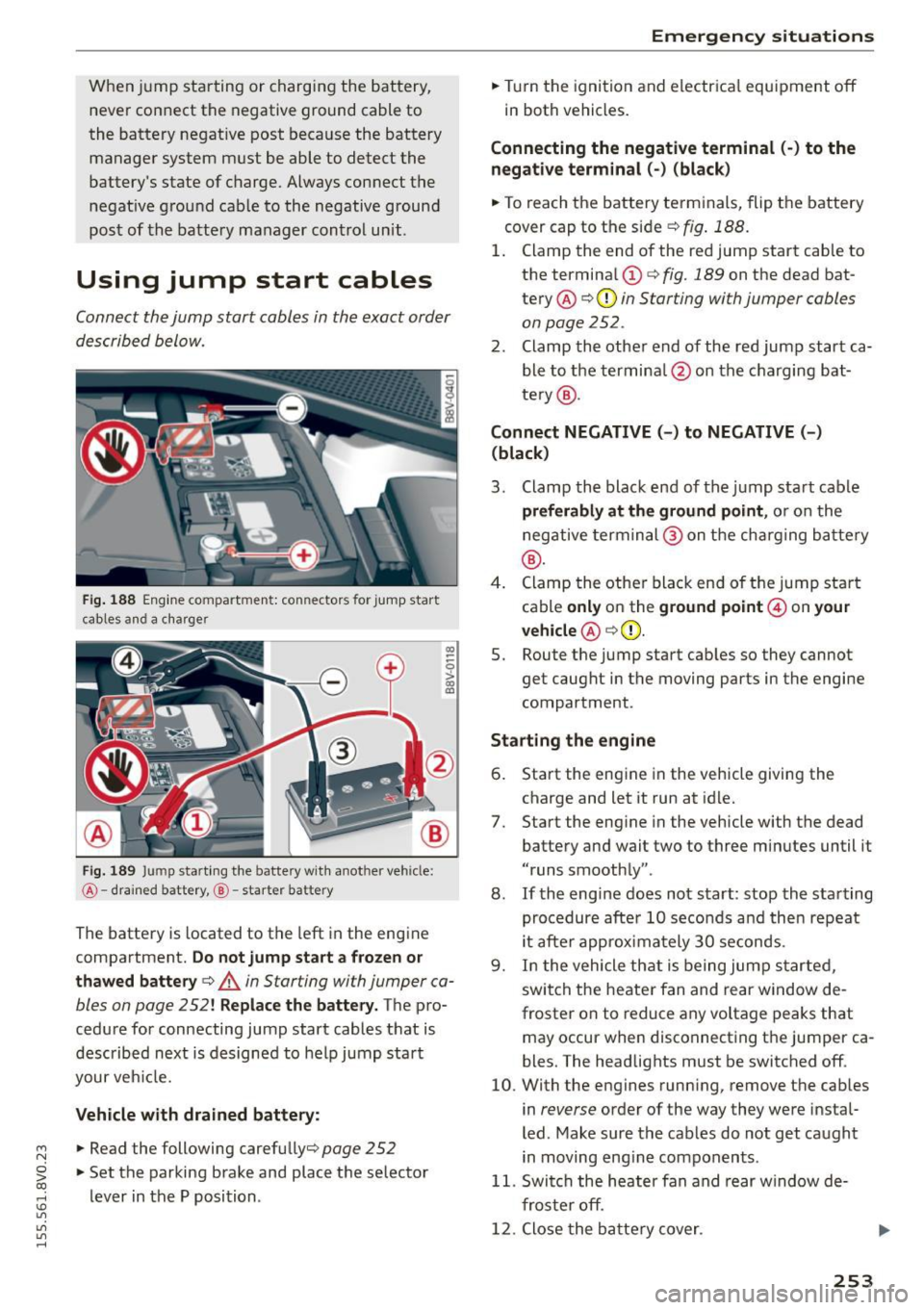
....,
N
0 > co
rl I.O
"'
"'
"'
rl
When jump starting or charging the battery,
never connect the negative ground cable to
the battery negat ive post because the battery
manager system must be able to detect the
battery's state of charge. Always connect the
negative g round cab le to the negative ground
post of the battery manager control unit.
Using jump start cables
Connect the jump start cables in the exact order
described below.
Fig. 188 Engine compa rtment: connectors for jump start
cables and a charger
Fig. 189 Ju m p sta rting the battery with anot her veh icle:
@ -drained battery, @-starter battery
The battery is located to the left in the eng ine
compartment.
Do not jump start a frozen or
thawed battery
c> A in Starting with jumper ca
bles on page
252! Replace the battery. The pro
cedure for connecting jump start cables that is
described next is designed to help jump start
your veh icle.
Vehicle with drained battery: .. Read the following carefullyc>
page 252
.. Set the parking brake and place the selector
lever in the P position .
Emergency situations
.. Turn the ignition and electrica l equipment off
in both vehicles.
Connecting the negative terminal(-) to the
negative terminal(-) (black)
.. To reach the battery terminals, flip the battery
cover cap to the side
c> fig . 188 .
1. Clamp the end of the red jump start cable to
the terminal © c>
fig. 189 on the dead bat
tery ®
¢0) in Starting with jumper cables
on page 252 .
2. Clamp the other end of the red jump start ca
ble to the terminal@on the charging bat
tery @.
Connect NEGATIVE (-) to NEGATIVE (-)
(black)
3 . Clamp the black end of the jump start cable
preferably at the ground point , or on the
negative term inal @ on the charg ing battery
® ·
4. Clamp the other black end of the jump start
cable
only on the ground point@) on your
vehicle ®
¢(D.
5. Route the jump start cab les so they cannot
get caught in the moving parts in the engine
compartment .
Starting the engine
6. Start the engine in the vehicle giving the
charge and let it run at idle.
7. Start the engine in the vehicle with the dead
battery and wait two to three minutes until it
"runs smoothly" .
8. If the engine does not start: stop the starting
procedure after
10 seconds and then repeat
it after approximately
30 seconds .
9. In the vehicle that is being jump started,
switch the heater fan and rear window de
froster on to reduce any voltage peaks that
may occur when disconnecting the jumper ca
bles. The headlights must be switched off .
10. With the engines running, remove the cables
in
reverse orde r of the way they were instal
led . Make sure the cables do not get caught
in moving eng ine components .
11. Switch the heater fan and rear w indow de
froster off .
12 . Close the battery cover .
253
Page 256 of 282

Emerg enc y s it uat ion s
The battery is vented to the outside so that not
gases enter the passenger compartment. Make
sure that the connected pos itive terminal clamps
on the jump start cable have sufficient contact
with metal.
A WARNING
Follow the warnings and instructions from
the jump start cable manufacturer to reduce
the risk of ser ious injuries and vehicle dam
age. If you are unsure about anyth ing, call
roadside assistance.
- The jump start cables must be long enough
so that the vehicles do not touch.
-
- Route the jump start cab les so they cannot
get caught in the moving parts in the engine
compartment.
- Always read and follow the warni ngs befo re
c he ck ing anything in t he engine compa rt
ment
¢page 198.
(D Note
Connecting jump start cables incorrectly can
destroy the alter nator.
- Always connect the positive term inal(+) to
the positive te rm inal(+) and the negative
te rmi nal(-) to the negat ive termina l(-) on
the body ground point, b ut no t the negat ive
te rminal on t he ba ttery.
- M ake sure the screw pl ugs on the batte ry
ce lls are insta lled securely.
If no t, tighten
the plugs before connec ting the clamps to
the negat ive termina l on the battery.
- Please note that the conne ct ing p rocess de
scribed below for the jump start cables is in
tended for when your ve hicle is being jump
started. If you are jump starting another ve
hicle, do not connect the negative cable to
the negat ive termina l(·) on the drained bat
tery, but rather connect it to a large metal
component that is bol ted secu rely to the en
g ine block, o r to the engine bloc k itself. If
the battery in the vehicle being jump start
ed is no t vente d to the outs ide, there is a
risk of explosion due to hyd rogen gas.
- M ake sure tha t the connected positive ter
min al cl amps h ave sufficie nt contact with
me tal.
254
- Do not use the battery negative terminal for
jump starting or a ma lfunction co uld occur
in the vehicle electrica l system.
Towing with a tow truck
General hints
Your Audi requires special handling for towing.
The following information is to be used by com
merc ial tow truck operators who know how to op
erate their equipment safely.
- Never tow yo ur Audi. Towing will cau se dam·
a ge to the engine and t ransmission.
- Never wrap the safet y chain s or winch cables
around the brake line s.
- To prevent unnece ssary damage, your Audi
must be t ran spo rted with a flat bed truck.
- To load the vehicle on to the fl at bed , u se the
towing loop found in the veh icle tools and at
t a ch to the front o r rear an chorage
¢page 255 and ¢page 255.
A WARNING
A vehicle being towed is not safe for passen
gers. Never a llow anyone to ride in a vehicle
being towed, fo r any reason.
Page 257 of 282
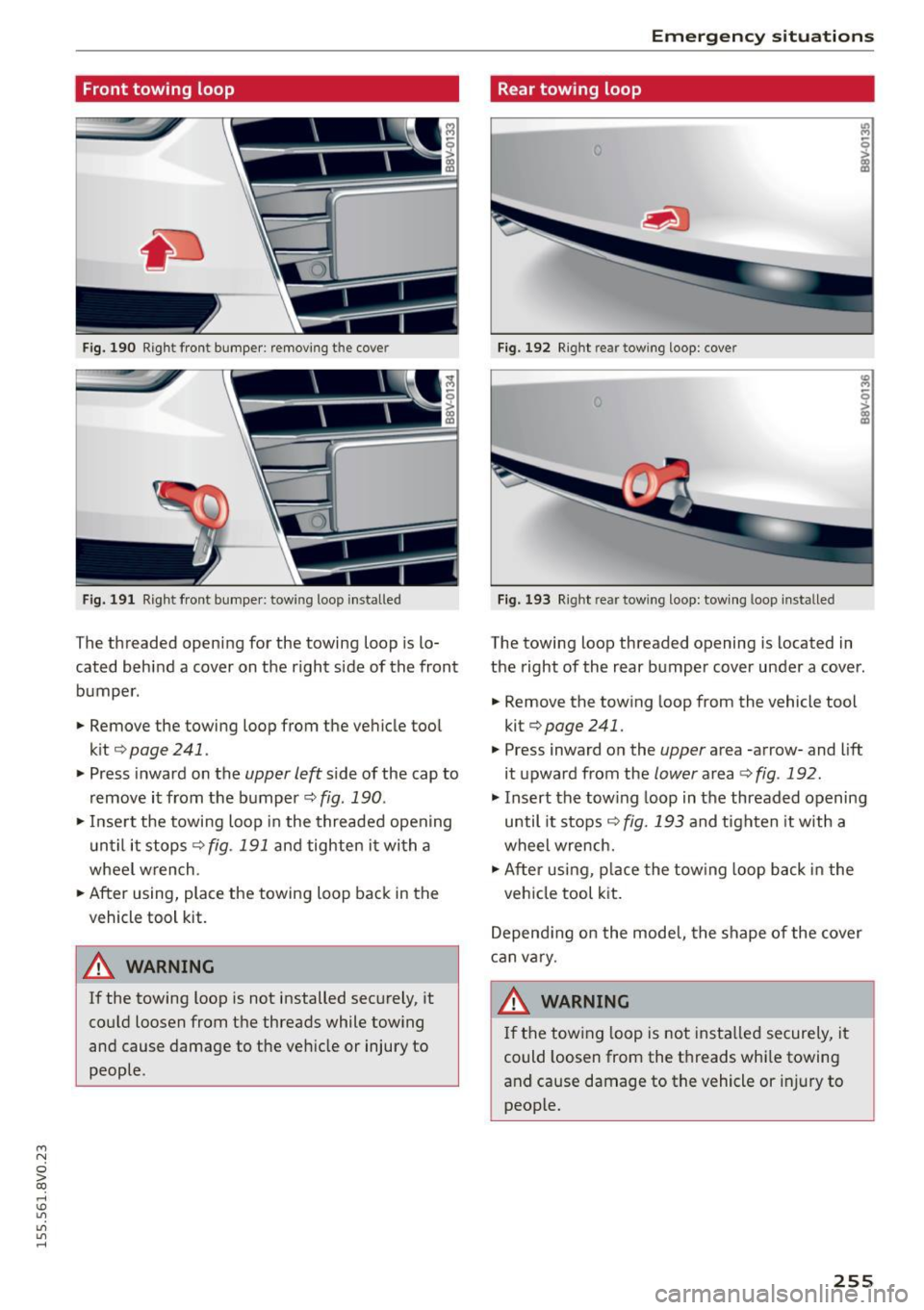
....,
N
0 > co
rl I.O
"'
"'
"'
rl
Front towing loop
Fig. 190 Right front bumper: removing the cove r
Fig. 191 Right front bumpe r: tow ing loop installed
The threaded opening for the towing loop is lo
cated behind a
cover on the right side of the front
bumper .
• Remove the towing loop from the vehicle tool
kit
¢ page 241 .
• Press inward on the upper le~ side of the cap to
remove it from the bumper
r::::> fig. 190.
• Inse rt the towing loop in the threaded open ing
u ntil it stops ¢
fig. 191 and tighten i t with a
wheel w rench.
• After using, place the towing loop back in the
vehicle tool kit.
A WARNING
If the towing loop is not installed securely, it
could loosen from the threads while towing
and cause damage to the veh icle or injury to
people.
Emergency situations
Rear towing loop
Fig. 192 Right rea r tow ing loop: cove r
Fig. 193 Righ t rea r tow ing loop: towing loop installed
The towing loop threaded opening is located in
the right of the rear bumper cover under a cover .
• Remove the towing loop from the vehicle tool
kit¢
page 241 .
.,. Press inward on the upper area -arrow- and lift
it upward from the
lower area¢ fig. 192.
.,. Insert the tow ing loop in the threaded opening
until it stops ¢
fig. 193 and tighten it with a
wheel wrench.
• After using, pla ce the towing loop back in the
vehicle tool kit.
Depending on the model, the shape of the
cover
can vary.
WARNING
If the towing loop is not installed securely, it
could loosen from the threads while towing
and cause damage to the vehicle or injury to
people .
255
Page 258 of 282
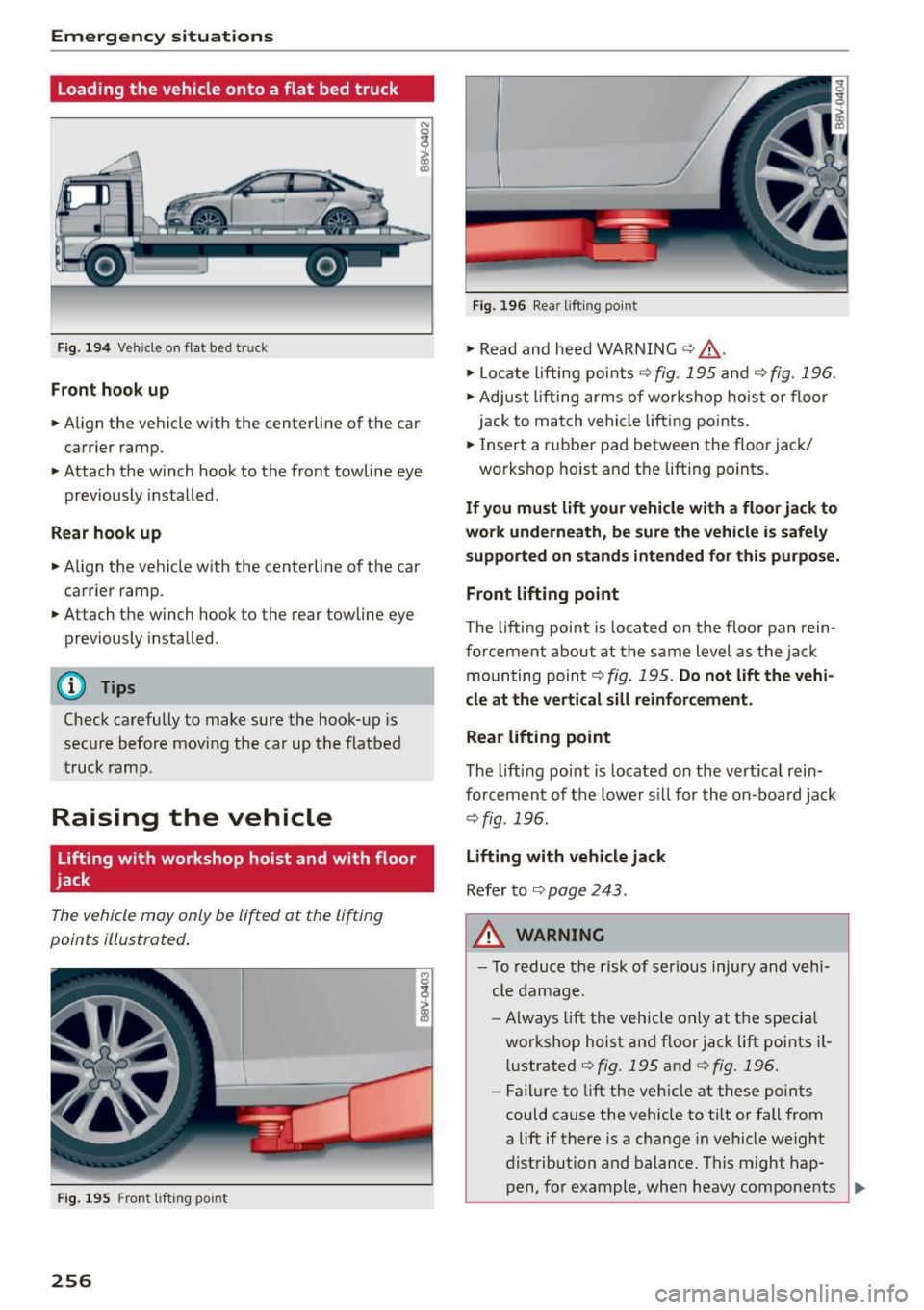
Emergency situation s
Loading the vehicle onto a flat bed truck
Fig. 194 Ve hicle on flat bed tr uck
Front hook up
.. Align the vehicle w ith the centerline of the car
carrier ramp.
.. Attach the winch hook to the front towline eye
previously installed .
Rear hook up
.. Align the vehicle with the centerline of the car
carr ier ramp .
.. At tach the winch hook to the rear towline eye
previously installed .
@ Tips
Check carefully to make sure the hook-up is
secure before moving the car up the flatbed
truck ramp .
Raising the vehicle
Lifting with workshop hoist and with floor
jack
The vehicle may only be lifted at the lifting
points illustrat ed .
F ig . 19 5 Fron t lifti ng po int
256
Fig . 19 6 Rear lift ing po int
.. Read and heed WARNING ¢ .&, .
.. Locate lifting poi nts ¢ fig . 195 and ¢ fig. 196 .
.. Adjust lifting arms of wo rkshop hoist o r floor
jack to match vehicle lift ing points .
.. Insert a rubbe r pad between the floor jack/
workshop hoist and the lift ing po ints .
If you mu st lift your vehicle with a floor jack to
work underneath, be sure the vehicle is safely
supported on stands intended for this pu rpose .
Front lifting point
The lifti ng point is located o n the floo r pan rein
fo rcement about at the same level as the ja ck
moun ting poin t¢
fig. 195. Do not lift the vehi·
cle at the ve rtical sill reinfor cement.
Rear lifting point
The lifting po int is located o n the vert ica l re in
forcement of the lower s ill for the on -boa rd ja ck
¢ fig . 196.
Lifting with vehicle jack
Refer to ¢ page 243.
,&. WARNING
-To reduce the risk of serious injury and vehi
cle damage.
- Always lift the vehicle only at the specia l
wor kshop hoist and f loor jack lift points il
l ustrated ¢
fig. 195 and¢ fig. 196.
-Fail ure to lift the veh icle at these points
could cause the vehicle to tilt or fall from
a lift if there is a cha nge in vehicle weight
distributi on and balance . This might hap-
pen, for example, when heavy components .,,_
Page 259 of 282
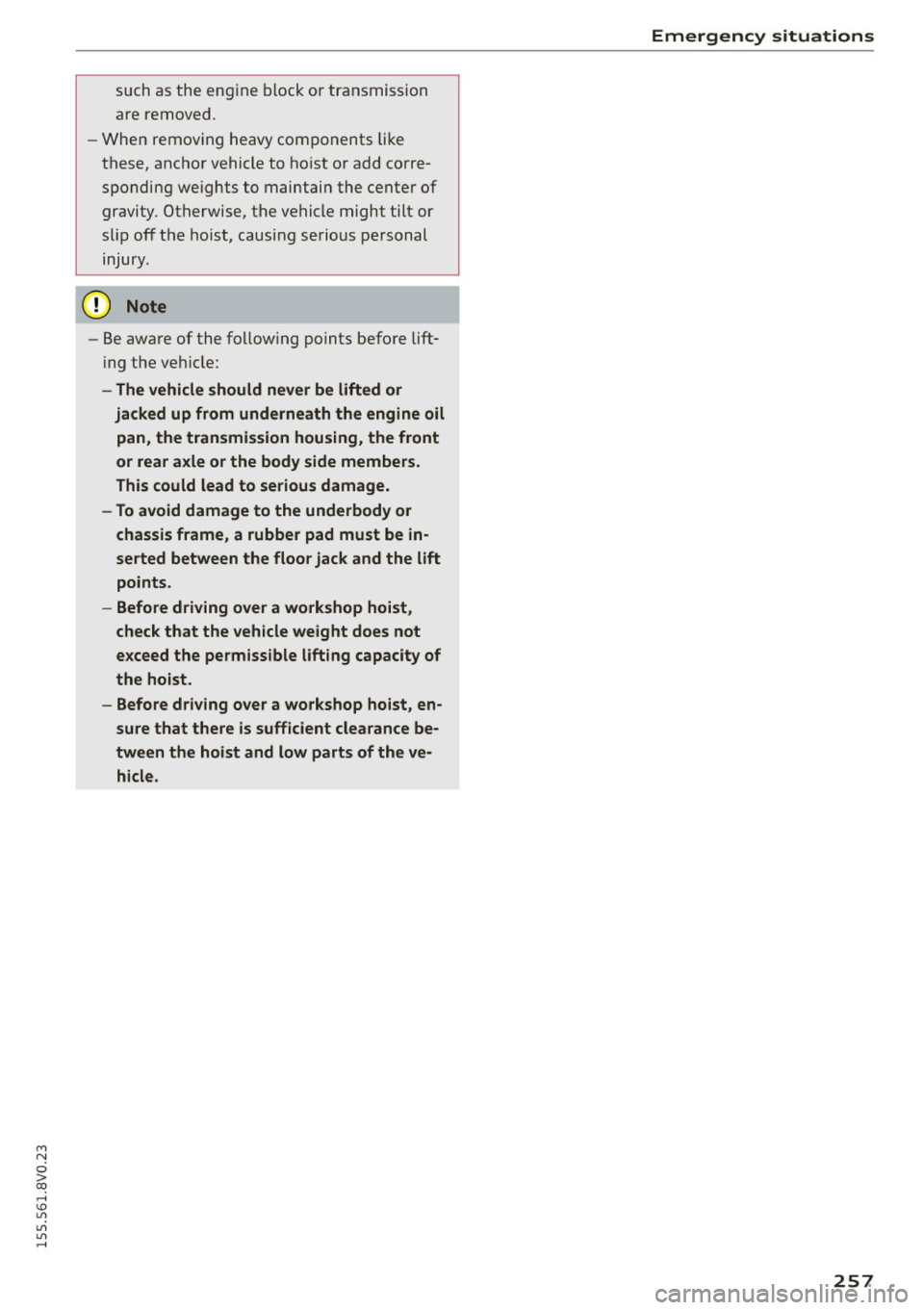
M N
0 > co ,...., \!) 1.1"1
1.1"1
1.1"1
,....,
such as the engine b lock or transmission
are removed .
- When removing heavy components like
these, anchor vehicle to ho ist o r add corre
sponding weights to maintain the center of
gravity . Otherwise, the vehicle might tilt or
s li p off the hoist , causi ng se rious pe rsonal
injury .
([) Note
-Be awa re of the fo llowing points befo re lift
i ng t he ve hicle:
-The vehicle should never be lifted or
jacked up from underneath the engine oil pan, the transmission housing, the front
or rear axle or the body side members.
This could lead to serious damage.
- To avoid damage to the underbody or
chassis frame , a rubber pad must be in·
serted between the floo r jack and the lift
points.
- Before driving over a wo rkshop hoist,
check that the veh icle weight does not
e xceed the permiss ible lift ing capacity of
the hoist.
- Before driv ing over a workshop hoist, en
sure that there is sufficient clearance be
tween the hoist and low parts of the ve
hicle .
Emergency s ituations
257
Page 260 of 282
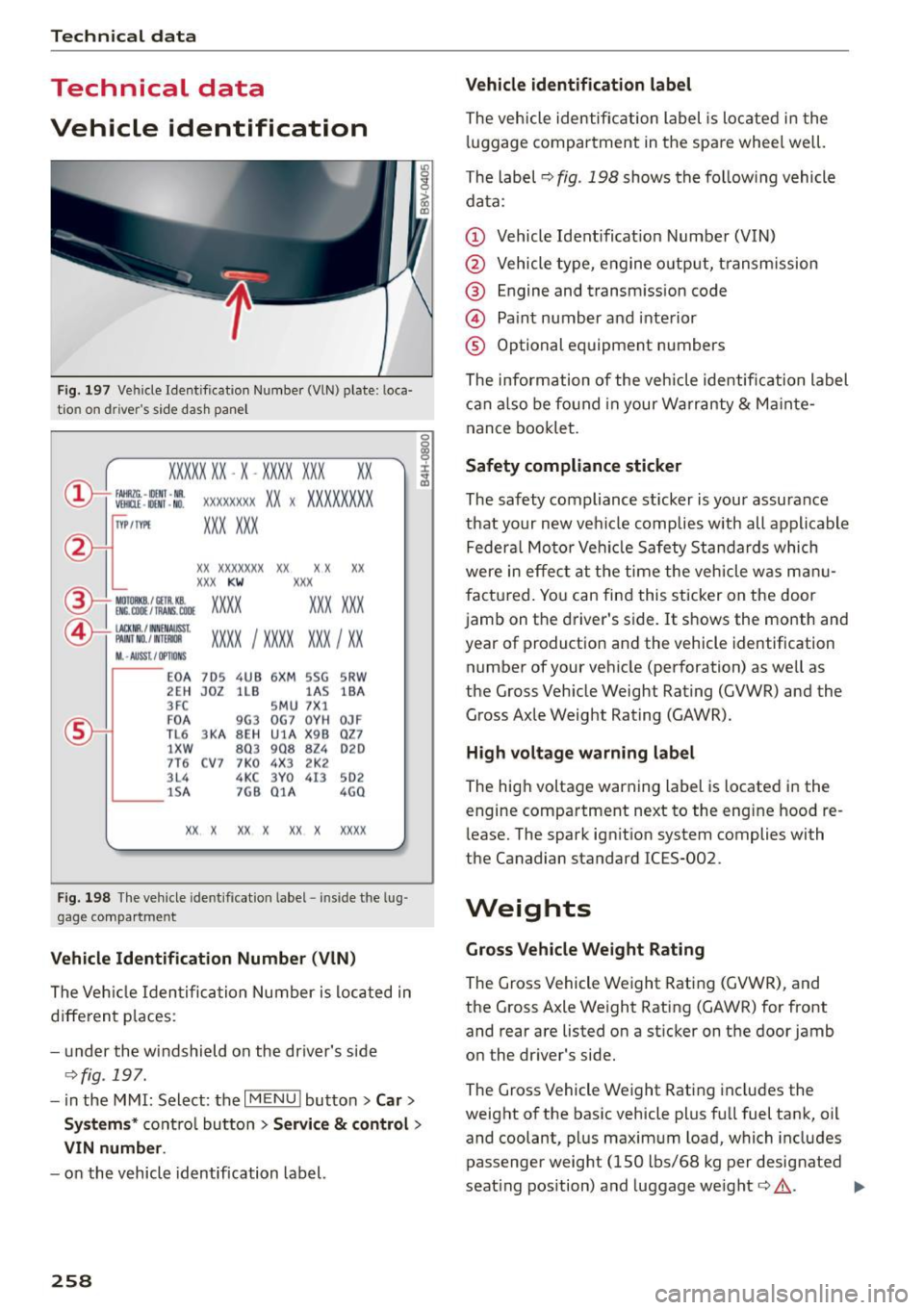
Technical data
Technical data
Vehicle identification
F ig. 197 Ve hicle Ident if icat ion Number (VlN) p late: loca·
tio n on d river 's side dash pane l
XXXXX XX -X -XX XX XXX XX
@-+ ~J:~t::1 ::: xxxxxxxx xx x xxxx xxx x
IYP lf'VPE XXX X XX
XX XXXXXXX XX X X XX
XXX KW XXX
\YT IM:.COll/fAANS ,COOE XXX XXX 15\_L I MOIOlll
@-+ ~~
1
:tr:~i XXXX I XXXX XXX I XX
II. -AUSST . / OPTIO NS
EO A 7D5 4UB 6X
M SSG SR W
2EH JOZ lLB lAS
1BA
3FC SM U 7 X1
FO A
9G3 O
G7 OY H
OJF
TL 6 3 KA BEH UlA X 9B Q
Z7
l XW
803 908
8Z4 020
7T6 C V7 7 KO 4X3 2K2
3L4 4KC 3YO 413
502
lS A 7GB 01A
4GO
XX X XX X
XX X xxxx
Fig. 198 The ve hicle ide ntif ic ati on label - inside t he lug ·
gage compar tmen t
Vehicle Identificat ion Number (VlN )
The Veh icle Iden tifica tion Number is located in
differen t places :
- u nder the windshield on the driver's side
¢ fig . 197.
- in the MMI: Select: the I MENU I button> Car >
System s* cont ro l button > Service & control >
VIN number .
-on the vehicl e identification label.
258
Vehicle identification label
The vehicle identification label is located i n the
l uggage compartment in the spare whee l we ll.
The label
9 fig . 198 shows the follow ing vehicle
da ta:
(D Vehicle Ident ificat ion Number (VIN)
@ Vehicle type, engine o utput, transmission
@ Engine and transm ission code
@ Pa int number and interior
® Optional equipment numbers
The information of the vehicle identification label
can also be fo und in your Warranty
& Ma inte
nance booklet.
Safety complianc e sticker
The safety compliance sticker is your assurance
that your new vehicle complies with all applicable
Federa l Mo to r Ve hicl e Safety Standards which
were in e ffect at the time the vehicle w as m anu
factured. You can find this sticker on the door
jamb on the d river's s ide. It shows the month and
year of production and the vehicle identification number of your veh icle (perforation) as we ll as
the Gross Veh icle Weight Rating (GVWR) and the
Gross Axle Weight Rating (GAWR).
H igh volt age warning label
The hig h voltage warning label is located i n the
engine compartment next to the engine hood re
l ease. The spark ignition system complies with
the Canadian standard ICES-002 .
Weights
Gross Vehicle Weight Rating
The Gross Vehicle Weight Rating (GVWR), and
the Gross Axle We ight Rating (GAWR) for front
and rear are listed on a st icker on the door jamb
o n the dr iver 's side.
The Gross Vehicle Weight Rating includes the
weight of the basic vehicle plus fu ll fuel tank, oil
and coolant, plus maxim um load, which includes
passenger weight (150 lbs/68 kg per designated
seat ing pos ition) and luggage weight ¢,&. . ..,_